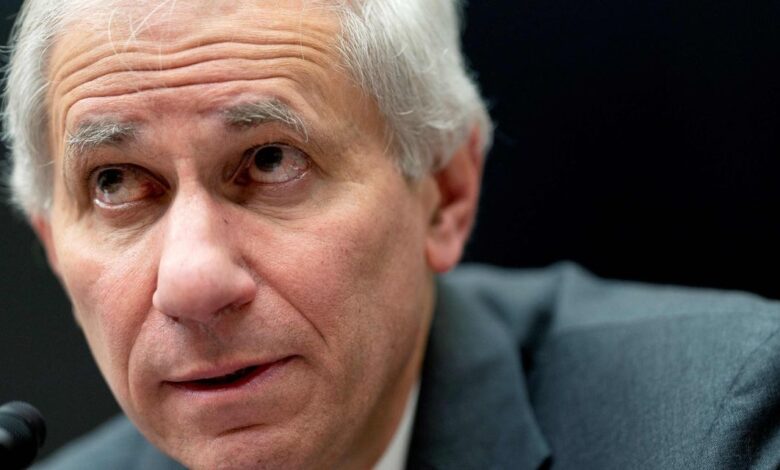Failed banks cost the deposit insurance fund $22.5 billion. Who will pay?

[ad_1]
Recent bank failures have blown a $22.5 billion hole in the insurance fund that protects bank customers–sparking a debate over who will pay to patch it up.
The collapse of Silicon Valley Bank is expected to cost the Federal Deposit Insurance Corp.’s deposit insurance fund roughly $20 billion, the agency estimates, while Signature Bank
SBNY,
failure will cost about $2.5 billion. The bulk of those costs relate to covering deposits at the two banks that exceeded the standard federal deposit-insurance limit of $250,000, FDIC chair Martin Gruenberg said in Congressional testimony this week.
The FDIC in May will propose a special assessment on banks to repay the insurance fund’s losses stemming from the uninsured deposit coverage, Gruenberg said in his testimony.
The proposal comes amid a longer-term debate–predating this year’s bank failures–about how to shore up the fund, which fell below its legally mandated funding level in recent years. The deposit-insurance fund, which held just over $128 billion at the end of 2022, is funded mainly through quarterly fees paid by insured banks, and any changes in those fees can stir controversy. Banking industry groups last year opposed the FDIC board’s vote to raise deposit insurance assessment rates by 0.02 percentage point–a move that was needed, the FDIC said, to help the insurance fund reach its required minimum funding level.
Now, industry players are raising concerns about how the special assessment tied to the bank failures will be allocated among banks. “The idea that all banks now should have to pay–that is a really difficult pill to swallow,” Anne Balcer, who heads government relations for the community-banking trade group Independent Community Bankers of America, told MarketWatch. “Our banks are not the ones who create these types of issues or present this type of risk to the deposit insurance fund.”
Lawmakers have raised similar concerns as Congress held hearings on the bank failures this week. “Can you tell me how it’s possible, when this special assessment fee process is completed, that my community bankers aren’t going to wind up disproportionately paying for the mistakes and the folderol of the biggest institutions in the country?” Rep. Frank Lucas, an Oklahoma Republican, asked Gruenberg during a House Financial Services Committee hearing Wednesday.
Gruenberg responded that the proposal would be put out for public comment and that “we’ll be keenly sensitive to the impact” on community banks.
Banks may pass costs on to consumers
Some industry experts also say consumers will ultimately pay a price for the extra assessment levied on banks, as banks cut back on services or pass costs along to customers in the form of less favorable rates or additional fees.
The debate comes amid a longer-term effort by the FDIC to prop up the insurance fund, which has fallen below its required funding level since the onset of the pandemic. Legally, the fund has a minimum “reserve ratio”–the fund’s balance as a percentage of the banking industry’s estimated insured deposits–of 1.35%. A surge of insured deposits around the start of the pandemic pushed the fund below that level. The FDIC also has a longer-term goal of boosting the reserve ratio to 2% to help the fund withstand financial crises.
At the end of 2022, the fund’s reserve ratio was 1.27%, compared with 1.26% a year earlier. The losses tied to Silicon Valley Bank and Signature will put a major dent in that reserve ratio, pushing it “way below” the 1.35% target, said Bert Ely, a banking consultant. “We’re going to have a lot of pushback from the banking industry as to how fast the fund should be pushed up” to a higher reserve ratio, Ely said. By law, when the funding level falls below the minimum, the FDIC has about eight years to get the ratio back to 1.35%.
The insurance fund’s estimated costs tied to the recent bank failures also outweigh the total amount the fund has collected from bank assessments in the past couple of years. The fund’s assessment revenue was $8.3 billion in 2022 and $7.1 billion in 2021, according to the FDIC’s annual report. The fund also earns interest on U.S. Treasury securities it holds, but a sharp rise in interest rates last year caused unrealized losses on those holdings, the report said.
In a joint statement reacting to the FDIC’s vote to raise assessment rates last year, the American Bankers Association and four other industry groups called the increase “a preemptive strike against a nonexistent threat.” Although the rate increase may have looked small in percentage terms, it was significant in dollar terms for many community banks, Balcer, of the community banking association, said.
“Of course, none of our insured banks want to pay higher premiums,” FDIC board member and Consumer Financial Protection Bureau director Rohit Chopra said in an October statement supporting the rate increase. But the insurance fund balance has dipped into negative territory a couple of times in recent decades, he said in the statement, and “failing to take this step would be a gamble” and risk violating the law.
As it designs the special assessment tied to the recent bank failures, the FDIC can take into account the types of entities that are benefiting from the action as well as economic conditions and impact on the industry, Gruenberg said in his Congressional testimony this week.
For community banks, “we’d rather not have that assessment hit at all,” Balcer said. The FDIC has considerable discretion, she said, “in terms of how to divide this up.” But part of the challenge, she said, is determining the threshold for exempting smaller banks from the assessment–whether that’s an asset size of $20 billion, $50 billion, $100 billion or some other level. “No matter where you draw the line,” she said, “someone will be unhappy.”
[ad_2]
Source link



